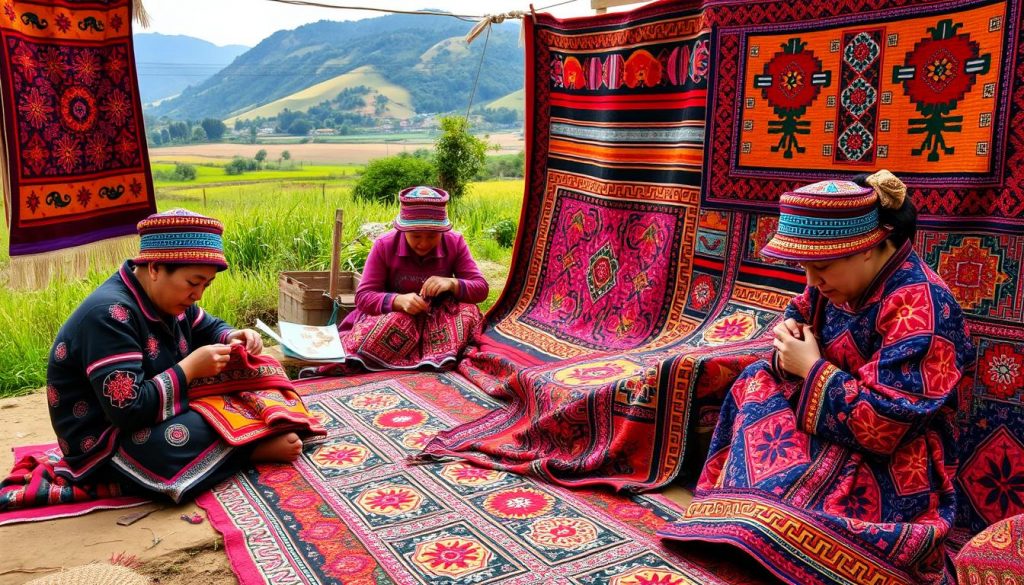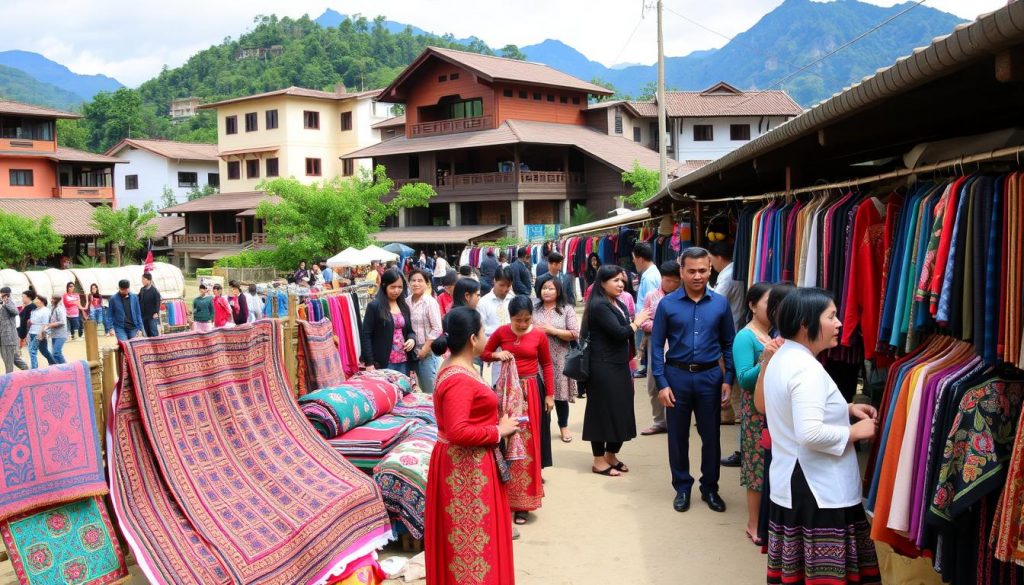The Hmong: A Culture of Quilts and Stories.
The Hmong culture is rich and colorful, shown through their beautiful quilt-making. These quilts are more than just textiles; they tell stories.
Anúncios
Each one captures important moments and the heart of Hmong traditions.
Quilts are key in keeping Hmong stories alive. They show scenes of everyday life and their journey from Laos. These quilts are not just art; they symbolize strength and shared experiences.
They are celebrated during the Hmong New Year.
The Rich History of the Hmong People
The Hmong people have a long and rich history, spanning over 4,000 years. They originated in southern China, near the Yellow and Yangtze rivers. Their name, “Hmong,” means “free,” showing their long fight for freedom.
Anúncios
The Hmong faced many challenges, like heavy taxes during the French protectorate in Laos from 1893 to 1940. After the Vietnam War, many Hmong left Laos due to persecution. Since 1975, thousands have moved to countries like the United States, Canada, and Germany.
They played a big role in global conflicts, like the Vietnam War. The CIA recruited over 19,000 Hmong men for operations. Sadly, about 35,000 Hmong people in Laos died in the war and its aftermath.
Now, most Hmong Americans live in California, Minnesota, and Wisconsin. They have made a strong impact in their new homes. Over 95% of Hmong Americans work, and nearly 70% own homes. Their journey shows their strength and the lasting effect of their migration patterns on their culture.
The Migration Journey of the Hmong
The Hmong migration journey is a story of strength and change in hard times. After the Vietnam War, thousands of Hmong families had to leave their homes because of government attacks. They found temporary safety in Thai camps, where they shared stories of hope and survival.
In 1980, about 145,000 Hmong refugees moved to the U.S. This move was part of an agreement to help them escape the troubles in Southeast Asia.
In the early 1980s, many Hmong families settled in U.S. towns. One town had a class where almost 10% of the graduates were Hmong. This showed how well they were fitting into American life.
Thirteen years later, community events showed the growing role of Hmong people. These events welcomed families in Hmong, English, and Spanish, celebrating their diversity.
Cities like Saint Paul, Minnesota, became key parts of the local community because of the Hmong population. The journey of the Hmong has made them important in many neighborhoods, from Wisconsin to Michigan. Despite early challenges, Hmong youth still dream big, aiming for higher education.
Handcrafted Artistry: Hmong Quilting Traditions
Hmong quilting is a world of vibrant stories and art. It’s known for handmade textiles like paj ntaub, or “flower cloth”. These quilts have patterns that show nature, like stars and snails. They’re not just decorations; they tell the Hmong people’s stories and heritage.
Hmong quilting mixes old and new. It started as a female tradition and now uses modern materials. At Fresno Unified School District, summer camps teach young ones about Hmong culture, including paj ntaub. The class was so popular, it quickly filled up.

Fresno’s summer camps focus on Hmong heritage. Students learn embroidery and connect with their culture. These classes are very popular, showing young people’s interest in keeping Hmong art alive.
These quilts tell stories of the Hmong people’s history, like the Vietnam War and their migration. They keep the Hmong quilting tradition alive. For more, check out this Hmong pandau quilts webpage.
| Aspect | Description |
|---|---|
| Technique | Paj Ntaub (Flower Cloth) |
| Colors | Vibrant and Symbolic |
| Materials | Cotton, Synthetic Fabrics |
| Significance | Storytelling through Textiles |
| Generational Learning | Focus on Transmitting Needlework Traditions |
The future of Hmong quilting is bright. It will keep its traditions while embracing new ideas. Young people, schools, and the community are all working together. Together, they ensure Hmong quilts continue to tell stories and show the Hmong people’s strength.
Understanding the Meaning Behind Hmong Quilts
Hmong quilts are full of symbolism, showing deep personal and cultural stories. They are made with storytelling through textiles, where each quilt shares a unique story. The patterns and designs often mark important life events like weddings and births.
These quilts are more than just decorations; they hold the cultural significance of the Hmong people. The bright colors and detailed designs make homes beautiful and connect the community to their heritage. They also show clan identity and cultural values, with designs that are a shared language among the Hmong.
The gap between Hmong elders and younger people is important for keeping traditions alive. Elders want to keep Hmong culture alive, but kids are often pushed to follow American ways. Families talk about keeping cultural practices, like sewing, alive. These skills, learned young, help keep individual and group identity strong.
Every quilt made is a sign of Hmong culture’s strength. It shows how to mix history, tradition, and identity into beautiful art. The story of these textiles keeps growing, blending old significance with new expressions.
The Role of Women in Hmong Quilting Culture
In Hmong quilting culture, Hmong women artisans play a key role. They keep their traditions alive and celebrated. Girls start learning to sew at five, memorizing hundreds of designs. This connects them deeply to their heritage.
Women’s role in quilting goes beyond just making art. It’s also a way to earn money. In the U.S., they use new fabrics and marketing. They sell their work at fairs, building support and financial stability.
Women spend a lot of time on their quilts, especially for special events. A girl might spend a year on one quilt. These quilts tell stories of their history and struggles.
Groups in Thailand support Hmong women artisans. They teach leadership and sewing skills. This helps women earn a steady income, keeping their quilting alive for future generations.
hmongculture: A Blend of Tradition and Adaptation
The Hmong community shows a unique mix of tradition and adaptation. They balance their rich cultural heritage with modern American ways. Sunisa Lee’s Olympic journey is a great example of this blend.
Language is key in this balance. Learning English can open doors to better jobs. But, if young Hmong people don’t learn their ancestral language, they might lose touch with their traditions.

Children in Hmong families often help bridge their culture with America. This role is crucial for keeping traditions alive. Yet, joining mainstream culture can also lead to losing some traditions.
| Aspect | Traditional Hmong Culture | Contemporary Practices |
|---|---|---|
| Language | Hmong language preservation | Adoption of English for better job opportunities |
| Cultural Practices | Shamanism, Paj Ntaub, New Year’s celebrations | Participation in mainstream cultural events |
| Generational Dynamics | Focus on tradition and cultural education | Younger generations leaning towards assimilation |
| Community Representation | Strong presence of elders | Involvement of children as culture translators |
Keeping a balance between tradition and modern life helps Hmong people find their place. The Hmong community’s growth in today’s world is a story of adaptation and heritage. It’s important for them to keep their culture alive as they move forward, as seen here.
From Refugees to Quilters: Resilience in Hmong Communities
The Hmong community’s journey from refugees to artisans is truly inspiring. Families, after facing displacement, found new homes where quilting became a key income source. This shows their ability to adapt and succeed despite obstacles.
Quilting is more than a craft for the Hmong; it’s a way to keep their history alive. Organizations like The Hmong Institute help these artisans by showcasing their work. For example, the exhibit “Resiliency: Hmong Women’s Mental Health Journeys During the COVID-19 Pandemic” in May 2023 shares stories of strength and community.
These stories focus on community, spirituality, and gardening. They show the Hmong’s ability to overcome adversity. This resilience is not just inspiring but also sets a strong foundation for future generations.
| Theme | Description |
|---|---|
| Community Connection | Strength derived from familial bonds and support networks within the Hmong community. |
| Spirituality | The role of faith in providing hope and strength during challenging times. |
| Gardening/Outdoors | Interactions with nature as a source of mental health and community engagement. |
The exhibition ended in Eau Claire by June 2023. It showed how far the Hmong community has come since the 1980s. Elder Hmong women’s stories highlighted the importance of keeping cultural practices alive while adapting to new environments.
This legacy of creativity in the face of hardship is a testament to the Hmong diaspora’s success. It reinforces their identity as influential and resilient artisans in America.
Hmong Quilting Styles: Exploring Paj Ntaub
Paj ntaub, also known as Flower Cloth, is a unique part of Hmong quilting. It’s known for its bright colors and detailed patterns. Each piece tells a story, showing the culture and life of the maker.
Making paj ntaub can take from a week to months. It depends on the design’s complexity and the artist’s time. Ying Yang and Xong Lee are examples of those who keep this tradition alive through ACTA’s Apprenticeship Program.
Since the 1980s, Hmong women have been making quilts in places like Lancaster County, Pennsylvania. They learned in refugee camps, blending old traditions with new crafts. Paj ntaub is used for gifts and memorials, connecting past and present.
There’s a big talk about paj ntaub’s future. Yang and Lee worry that younger people might not be interested. But, there’s a growing interest, showing a new generation might take up this tradition.
Learning paj ntaub is a step-by-step process, as Lee’s journey shows. It’s a way to grow skills and keep cultural stories alive. This effort keeps family histories and cultural tales alive in the Hmong community.
Conclusion
The Hmong culture overview shows how quilts are key to the Hmong identity. These handcrafted pieces, known as paj ntaub, tell stories and keep history alive. They show the Hmong people’s strength and creativity.
In the United States, there are about 327,000 Hmong people. Most come from Laos. This shows quilts are more than just pretty designs.
In Minnesota, over 81,000 Hmong people live. They add a lot to America’s cultural mix. Hmong quilters keep their traditions alive, even in today’s world. They fight to be recognized for their art, keeping their stories real.
Quilts are more than fabric. They hold generations of stories, struggles, and victories. The Hmong’s story is one of courage. It shows quilts are symbols of pride and memory that will last for many years.
